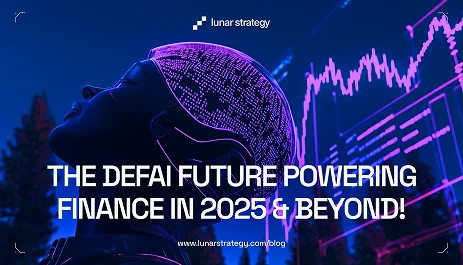The crypto market is currently valued close to $3.54 trillion, signaling both maturity and momentum. But success in this space means you have to launch it right, and here the devil is in the details. Timing matters, but so does your go-to-market (GTM) strategy. It’s not enough to just listen for the kettle’s whistle; it’s every small step that comes together to make it right. Similarly, without a clear plan for positioning, growth, and traction, even the most promising projects risk being overlooked. At Lunar Strategy, we’ve helped projects like Cookie DAO, Chain GPT and Paddle Finance craft tailored GTM strategies with strong narratives in preparation for what’s coming ahead.
The way crypto has entered mainstream conversation is reminiscent of the early days of the internet. Those who became well-versed in internet technologies reaped the greatest rewards. Remember dial-up connections? Back then, websites took minutes to load but now it happens in a second. The world has progressed tremendously since then. Imagine the level of advancement in crypto today.
Like the internet in its early stages, crypto is still growing. While the internet had its dot-com bubble, crypto has experienced its own booms and busts. Yet, the underlying technology and adoption continue to evolve.
Focusing on compounding growth
While most people limit their use of cryptocurrencies to buying and trading, it's the innovations driving sustained momentum:
- Smart Contracts: Self-executing agreements with terms embedded in code, removing the need for intermediaries.
- NFTs: Non-fungible tokens have transformed digital art, collectibles, and even tweets into unique, ownable assets.
- Scalability Solutions: Blockchain technology is advancing to handle more transactions per second, making it increasingly practical for everyday use.
The Market Evolution of Crypto
Crypto entered the markets quietly between 2010 and 2013 with Bitcoin, which was seen more as an experiment than a currency. It was a niche concept embraced by tech enthusiasts and visionaries aiming to challenge traditional finance. With limited infrastructure, they began laying the foundation. From 2014 to 2018, the space grew rapidly as companies like PayPal began accepting Bitcoin, and ICOs introduced a new funding model. This wave of innovation also brought attention to the need for better regulation. Hype and volatility took center stage, forcing the market to mature through hard lessons.
Since 2019, crypto has moved into a phase of strategic adoption. Institutional players like Tesla and MicroStrategy legitimized Bitcoin as a treasury asset, while DeFi unlocked decentralized financial services beyond banks. Blockchain evolved far beyond being a buzzword, as governments began exploring CBDCs and regulatory frameworks became more structured. Today, crypto is shifting from speculative investment to a core part of the global financial system—driven by innovation, regulation, and increasing real-world integration.
Why the Best Time in Crypto is Now
Nobody can deny the crypto market's incredible growth. Once considered an academic experiment, it is now recognized as a cornerstone of global finance. Savvy investors are prioritizing long-term utility and adoption over quick profits.
By investing today, you align yourself with a sector gaining mainstream traction. Institutions are developing blockchain-based tools, DeFi is expanding financial access, and major corporations are integrating crypto into their operations. The focus is shifting toward stability, adoption, and real-world value creation.
The Missed Chances and Present Goldmine
The Missed Opportunity:
- Buying $1,000 worth of Bitcoin back in 2010 would have been a life-altering decision. With Bitcoin's price skyrocketing over the years, that initial investment would now be worth millions, turning what was once the cost of two pizzas into the equivalent of purchasing a mansion. This story of Laszlo Hanyecz, who bought his now-famous pizzas with Bitcoin, gives us insight into the potential wealth left on the table by those who didn't recognize the early value of crypto.
- If you had invested in Ethereum during its crowdsale in 2014, when ETH was sold for around $0.31 per token, and held onto those tokens, you would have seen your investment multiply dramatically as ETH reached highs of nearly $4,000 in 2021.
Crypto in 2025 & Beyond
If you are ready for crypto interactions, the time to connect is now, as the market is expanding through institutional investments, the explosive growth of DeFi, and widespread blockchain adoption across diverse industries. Here's a closer look at how these trends are shaping the future of finance and technology:
Institutional Investments:
- Corporate Treasury Holdings: Companies have made it to the news just by adding Bitcoin to corporate treasuries while making it a strategic asset for long-term value preservation. Actions like these make people believe that Bitcon is treated as a legitimate asset, just like gold, diversifying corporate cash reserves against inflation and devaluation
- ETF Approval: The introduction of Bitcoin and other crypto ETFs (Exchange Traded Funds) by financial giants like BlackRock and Fidelity has opened the gates for institutional investors to gain exposure to cryptocurrencies without needing to hold the assets directly. With a regulated, more traditional investment vehicle, crypto will become more accessible to pension funds, insurance companies, and other large investors.
DeFi Expansion
- Ether in DeFi: The amount of Ethereum locked in DeFi protocols has grown dramatically, showing us the sector's health and the trust placed in these systems. DeFi allows for financial activities like lending, borrowing, trading, and earning interest directly on the blockchain without intermediaries. This reflects an innovative financial ecosystem where users can engage in complex financial products with just an internet connection
- Innovation in Finance: DeFi platforms are replicating traditional finance and progressing beyond that with concepts like yield farming, liquidity mining, and automated market makers. These innovations provide new ways to earn passive income, lend, or borrow, which were previously not possible or were highly centralized.
Blockchain Adoption
- Supply Chain Management: Blockchain's transparency and immutability make it ideal for tracking goods from origin to consumer, reducing fraud, and improving efficiency. Companies like Maersk are using blockchain for container shipping, ensuring all parties have real-time data.
- Voting Systems: In places like Estonia, blockchain technology is used for secure digital voting, enhancing the integrity of elections by providing a tamper-proof record of votes. This application could revolutionize voting worldwide, ensuring transparency and reducing the potential for electoral fraud.
- Identity Verification: Blockchain can provide a secure, decentralized way to manage identity, giving individuals control over their personal data. Projects aim to reduce identity theft, streamline KYC (Know Your Customer) processes, and support self-sovereign identity models where users manage their own data.
- Healthcare: Data integrity in medical records, drug supply chain tracking, and patient consent for data usage are areas where blockchain is being tested to ensure security and privacy.
- Real Estate: Tokenization of property on the blockchain allows for fractional ownership, making real estate investment more accessible and liquid, with all transactions recorded securely.
When we look at these trends together, we clearly see how cryptocurrencies and blockchain technology are moving from niche assets to integral parts of our technological and financial infrastructure. They suggest an increase in investment opportunities and a broader, real-world impact across various industries, showcasing blockchain's potential to disrupt traditional business models and practices.
Action Plan for Beginners:
Diversify your crypto investments. It's wise not to put all your digital eggs in one basket. Spread your funds across various assets to mitigate risk. Educate yourself thoroughly and grasp the essence of what you're investing in. Dive into the intricacies of market cycles, tokenomics, and the underlying technology of blockchain projects. When you're ready to invest, start small. Only commit what you can afford to lose, but take that first step. Remember, the crypto market presents opportunities at every investment level, so begin your journey with caution but with an eye towards growth.
Conclusion
While timing the market perfectly is nearly impossible, taking action now is crucial. It is okay to not catch the exact peak, as long as you are participating in a technology that’s reshaping our financial world.
Whether you're looking to invest, launch a project, or simply understand this space, the time to engage is now. The future of finance is being written, and you have the chance to be part of that story.
Remember, in crypto, the best time to invest was yesterday; but the next best time is as soon as you decide to get into it!
If you are someone who is planning to launch in 2025, connect with our team to know how to position your brand for success, over here.





































